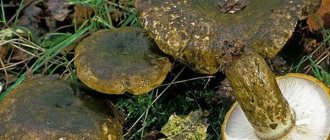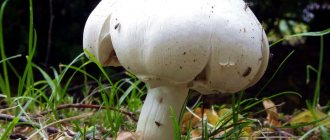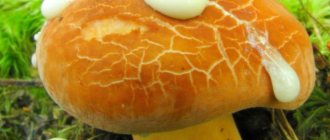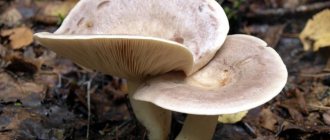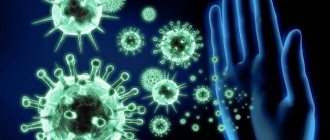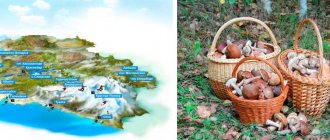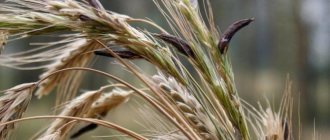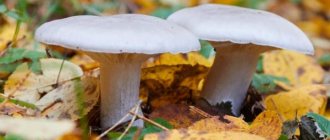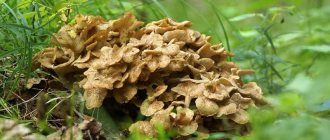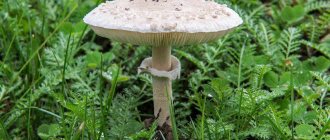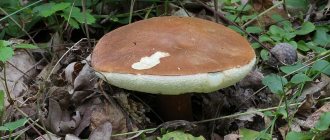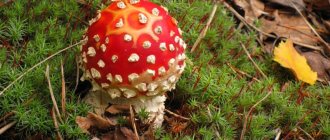The white or often lamellar podgruzdok belongs to the Russula family. This is one of the most famous mushrooms, it is also called dry mushroom, cracker.
The description of the load is very similar to the description of the milk mushroom. It has exactly the same cap shape, although without the fringed edges. The surface of the cap is white, dry, matte, the size reaches 20 cm in diameter, and sometimes has brown spots. In a young mushroom, the cap is slightly pressed in the center; in an adult, it looks like a funnel. The pulp is white in color and brittle. It has white plates or with a bluish tint. The leg is short and shaped like a cylinder.
White podgrudki are found in both coniferous and deciduous forests. They can be collected from July to October. Avid mushroom pickers collect them with special pleasure, because they grow in a friendly group. They hide under the leaves, literally have to be dug up, and are rarely found spoiled.
Often, sellers pass off white milk mushrooms as real milk mushrooms. A person who is well versed in mushrooms will be able to immediately say that what was sold to him was not a milk mushroom. A real milk mushroom has milky juice, a damp surface of the cap, and downward edges with a fringe.
At home, loadings can be salted and pickled. They have caustic plates and therefore their pulp should be processed more carefully than that of ordinary mushrooms. This careful processing will result in amazing flavor.
Podgruzdok differs from ordinary milk mushrooms in the absence of milky juice
Dry breast: photo and description
The mushroom cap reaches 5–18 cm in diameter. But you can find individual specimens with dimensions of 30 cm. At first, the cap is formed convex, then it is pressed in and takes the shape of a funnel. Her top is whitish. It may be dotted with dark yellow or red-brown spots. In dry weather, the surface of the cap often becomes covered with cracks.
The plates are located frequently. Their color is cream. They can intertwine with each other and fall on the leg. The leg is powerful, grows up to 5 cm in height and up to 4 cm in diameter. It is painted white. May become covered with blurry light brown spots. Its upper part is bluish, narrowed. The pulp is dense, brittle, white. When broken, it does not darken and does not emit milky juice.
Did you know? The largest mushroom in the world, listed in the Guinness Book of Records, is the dark honey fungus (Armillaria ostoyae).
It is 3.8 km long and grows in the USA. White podgruzdok grows in all types of forests. It can often be found under birch, oak, pine, spruce, alder, aspen, oak, and beech trees. Most often, mushrooms occupy damp areas of the forest and are found in small groups. Their collection time is July–October. According to the description, the mushroom grows large. You can see exactly how it looks in the photo.
Where it grows, in what forests and how to collect
You may be interested in: How do edible talkers differ from false mushrooms? How many days after rain do mushrooms grow? Bitter mushroom: photo and detailed description
In Russia, this type of mushroom grows mainly in the European part of the state.
Myceliums prefer deciduous plantings, but they are also found in coniferous forests (though much less frequently). Especially a lot of mushrooms can be found under birches, oaks, beeches - in general, the tree species favored by most mushrooms.
Myceliums bear fruit in groups. The loading season begins in mid-summer and lasts until early October. Having seen one cracker, you need to carefully look at the soil covering around it. There will definitely be a whole family nearby, securely hidden in the grass.
Why are milk mushrooms considered originally Russian?
Previously, in Rus', milk mushrooms were considered the only mushroom suitable for pickling. It was collected from the forests and salted. According to documentary sources, dishes with milk mushrooms were traditionally consumed during Lent. It was salted alone or mixed with other mushrooms - saffron milk caps, volnushki.
Wooden barrels were used for pickles. Milk mushrooms were eaten as an independent dish, and also added as a filling to pies, pies, and seasoned with horseradish or butter. For a long time, milk mushroom was the only industrial mushroom in Siberia.
Contraindications
Milky vegetables take a long time to digest and create a burden on the stomach, so stomach ulcers and gastritis can be identified as contraindications to their use. Also, milkweeds are contraindicated as food for children under seven years of age. Unprocessed and expired mushrooms can cause botulism.
Milk mushrooms are delicious, delicious mushrooms that grow in deciduous, mixed, and pine forests, and are divided into edible and inedible varieties. Due to the high content of lactic acid, they have a bitter taste, so they must be cleaned of the caustic liquid before cooking. Among the beneficial properties are nutritional and medicinal. The composition of these mushrooms is rich in protein and vitamins. Milkweeds are contraindicated for consumption in an unrefined form.
Poisonous doubles
The described milk mushroom has no poisonous counterparts. Among mushrooms similar to it, there are only edible or conditionally edible ones. Thus, dry milk mushroom can be easily confused with short-legged russula. However, it can be found very rarely and only in North America.
Did you know? The oldest mushroom was found in Brazil.
According to scientists, it is about 115 million years old. Another similar mushroom is greenish-plated mushroom. It is distinguished from dry milk mushroom by the presence of bluish plates.
Similar types are the false loader and violin. The first mushroom grows exclusively under oak trees, has a yellowish cap and bluish-green plates. The second representative of the mushroom kingdom is very similar in appearance to the white cap, but when broken, it releases milky juice.
About the Milkies in brief
It is a typical representative of the cap species. They come from the lamellar family. Often these include thick and fleshy fruits of medium and large sizes. The length of their legs is approximately equal to the diameter of the cap.
The caps are flat-convex, funnel-shaped, with often or barely noticeable water rings and clearly curved edges.
The legs are thick, cylindrical, partially hollow, and have a color similar to the cap of the fruit. The Latin name of this genus (Lactarius) “milk”, comes from the specificity of the pulp - when broken, a whitish liquid is released from it, often with a fruity aroma.
More than 400 species of laticifers are known in the world, and while most of those that grow in the vast expanses of Russia are considered edible, the same part that lives in Europe is the opposite...
The most common milk mushrooms in Russia are considered to be the aspen, pepper, and also the violin, milkweed, and oak milkweed, but the most famous is the real milk mushroom, the main feature of which is often called the unique crunch when salted
Beneficial properties and possible harm
White podgrudok has a rich vitamin and mineral composition. It contains vitamin A, groups B and P. It is rich in zinc, copper, and manganese. The pulp contains amino acids and fiber.
- Mushrooms can have the following beneficial effects on the human body:
- strengthen immunity;
- saturate with vitamin and mineral elements;
- normalize intestinal function.
A substance has been isolated from the loadings, which is used in medicine and pharmaceuticals in the treatment of cancer. You should be careful when consuming dry milk mushrooms. You should not overeat them, as they can overload the digestive tract.
As a result, nausea, vomiting, diarrhea, and abdominal pain may develop. Harm, in the form of poisoning, can be caused by dry milk mushrooms collected in environmentally unsafe areas - near busy highways, landfills, and large enterprises.
Important! In case of mushroom poisoning, it is necessary to induce vomiting, drink activated charcoal and drink a lot of cold water or strong black tea. The victim should immediately seek medical help and remain in bed.
Gorchak
The last crop we will consider is the bitter mushroom. The name speaks for itself - the pulp of the plant’s fruits is very caustic and bitter. It is noteworthy that the product is consumed as food, but only in salted form and subject to all preparation rules. Gorchak is considered a conditionally edible variety.
In order to recognize a dubious fruiting body, you need to know the following about the crop:
- The cap is slightly convex, and over time it turns into a funnel. Does not grow more than 9 centimeters in diameter.
- The surface is dry and has a red-brown color.
- The inner side is covered with yellow-red plates; when spores form, they may become covered with a white coating.
- The leg is high (from 6 to 9 cm), of medium thickness, the same color as the “head”.
- When damaged, the pulp releases juice.
We looked at what a white milk mushroom looks like, and also studied the characteristics and features of the product. Our article also provides examples of plants that closely resemble the crop we are studying. If the article helped you with answers to your questions, feel free to go on a “quiet hunt”, not forgetting the main rule of a mushroom picker - “if you are not sure of the edibility of the prey, do not collect!”
Taste qualities
White mushrooms have a pleasant, clearly distinguishable aroma and a sharp, fresh taste. Despite their mediocre taste, today they are actively used in cooking. These mushrooms are used to make soups and fry them. But, most often, pickles and picklings are made from dry milk mushrooms. Before preparing the rolls, the mushrooms are boiled. As a rule, they are not used in dried form.
Interesting Facts
The russula is pleasant.
- In some regions, this mushroom is valued along with, or even more than, the real milk mushroom, which is classified in the 1st taste category.
- Podgrudok white in the form of tinctures is used in folk medicine as a strong antitumor agent, which has proven its effectiveness, in particular, in the treatment of sarcoma.
- The white cap can be quite difficult to find due to the fact that only part of the cap, sprinkled with leaves and forest debris, is often visible above the ground. The rest remains underground.
- The white mushroom is soaked before salting not to remove bitterness or poisons, but to make it easier to clean the mushrooms from soil and various contaminants.
Growing
White podgruzok can be grown at home, for example, in a summer cottage or personal plot, in a garden, as well as in a park, greenhouse, flower bed, lawn. To do this, you need to purchase mycelium. This can be done in a specialized market or online store. 120–150 g of mycelium is required for growing under one tree or bush on an area of 2.5–3 m².
The landing technology is as follows:
- Loosen the soil in the area where you plan to plant the mycelium.
- Make a recess measuring 5–15 cm.
- Distribute the mycelium evenly over the prepared area.
- Cover with garden soil with added humus.
- Pour the soil dug out when forming the depression on top.
In the future, it is necessary to take care of the plantings - during a dry campaign, organize watering at the rate of a bucket of water per 1 m². The first harvest should be expected 5 months after planting.
Important! The shelf life of mycelium is 6 months at temperature conditions of +2°C...+6°C and 1 month at +23°C.
After this period, it is unsuitable for planting. So, dry milk mushroom is an edible mushroom, which, despite its mediocre taste, is actively used in cooking. It can be grown at home.
Black Podgrudok, Russula adusta
Hat:
Diameter 7-15 cm, first flat-convex, then flat-concave, initially white-grayish, then unevenly colored, dark olive-brown, black. The pulp is grayish, thick, brittle, at the break it first turns red, then turns gray. The taste is sweetish.
Hymenophore:
The plates are initially white, later grayish, darken when pressed, and are adherent.
Spore powder:
White.
Leg:
Relatively short and thick, 3-7 cm in length, up to 3 cm in thickness, cylindrical, solid, the same color as the cap or lighter, often with dark spots, darkens when pressed.
Spreading:
Russula adusta is found in a wide variety of forests from July to October, in large groups during good seasons. It often leads a semi-underground lifestyle, emerging only in old age.
Similar species:
There are plenty of similar mushrooms with gray caps and blackened flesh in the russula genus. The differences are quite minor. For example, blackened podgruzdok (Russula nigricans) - the pulp, when in contact with air, undergoes the same metamorphoses (from pink to dark gray), but there are sparse plates. Russula albonigra turns black radically, without any flirtation with the red part of the spectrum. R. acrifolia and R. densifolia have distinctly bitter flesh and change color much more quickly. It is curious that in good conditions, black loads of different types can grow intermixed, which gives the novice classifier enthusiast a particularly exquisite pleasure.
Edibility:
It is considered a good edible mushroom. Does not require any special measures.
Author's notes:
As you certainly already know, Russula adusta is the record holder for being visited by worms. (Only closely related species of black cape can compete with him - or her.) In our area it is often found, especially at the beginning of the fruiting period, from mid-July to mid-August, but I can say without exaggeration: I still don’t know what does it taste like? Once I found two (!) completely non-wormy mushrooms in a very damp, dark and completely non-mushroom broad-leaved forest in the Tula region, but it so happened that already at the preparation stage these specimens were mixed with other mushrooms, and I was never able to find out what This is what the larvae of mushroom flies find in this wonderful mushroom.
It is difficult to distinguish the black russula from other blackening russulas. The frequency of the blades is one of the signs that allows one to incline the mushroom to the species Russula adusta. One, but not the only one.
The mushroom, which, by the will of fate, spent most of its life under a thick layer of litter, comes out looking like this. And it’s good if it comes out - a significant part of the black loads will never see the light of day. However, why do you need light? Mushroom flies will find it by smell.
It is possible that mushroom flies are guided, among other things, by aesthetic flies - even for a person who, in general, can imagine what is going on inside, this mushroom looks more than appetizing.
